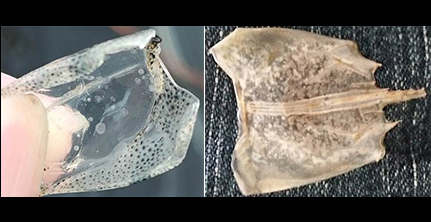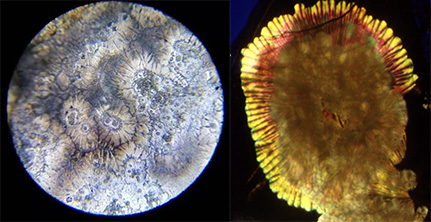Introduction to white spot syndrome virus (WSSV)
Numerous virus species are known to cause shrimp mortality, and WSSV is the hardest to prevent due to its wide host range, high infectivity and mortality. First reported in Taiwan in 1992, the virus rapidly spread to Japan and other Asian countries, then first cases were reported in South Texas, Ecuador and Brazil (Hasson et al., 2006; Galaviz-Silva et al., 2004).
WSSV virion is ovoid and has viral envelope. It is 210-420 nm in length and 70-167 nm in width (Lu et al., 1997). The nucleocapsid is 330-350 nm in length, has a diameter of 58-67 nm, and is presented in ovoid, spindle or rod form.
Sometimes tail-like appendages (for virion movement) are present on one side.
The viral nucleocapsid is enveloped by nucleocapsid subunits. As shrimp, being a crustacean, has open circulation system, virus can easily spread to any body part via hemolymph and form characteristic horizontal stripes 20 nm in width (Wang et al., 1995).
WSSV Host and Transmission
WSSV has a wide variety of hosts, primarily order Decapoda of Crustacea (Sanchez-Paz, 2010), and is especially contagious and fatal to shrimp and prawns, such as Asian tiger shrimp (Penaeus monodon), whiteleg shrimp (Penaeus vannamei), Japanese tiger prawn (Marsupenaeus japonicus) and Oriental shrimp (Penaeus chinensis). When infected in the post-larvae stage of life, Asian tiger shrimps soon succumb to the infection, with a mortality rate of 100% (Sanchez-Paz, 2010). WSSV may also infect other aquatic species including crabs, Copepoda and brine shrimp but with lower mortality. These infected specimens can become WSSV carriers (Lo et al., 1996; Lo and Kou, 1998).
Horizontal transmission
Asymptomatic shrimp, pool water, carrier, infected shrimp
Vertical transmission
Transmitted to offspring by eggs attached to or carrying the virus
WSSV Season
Temperature range of WSSV prevalence



Ideal temperature range of whiteleg shrimp



Tolerable temperature range of whiteleg shrimp



- As the change of water temperature is inevitable at seasonal transition, precautionary measures prior to the season are important
- Water temperature change, temperature fluctuation; afternoon thundershower, intermittent downpour
WSSV progression
The progression of WSSV spans three stages
Incubation (early stage)
- Infected shrimp may or may not exhibit clinical symptoms of WSSV
- Infected shrimp may still show normal swimming pattern or vigor
Transition
- Minuscule, white spots appear on exoskeleton
- Lasts only hours
Onset (late stage)
- Clinical symptoms of WSSV develop
- Infected shrimps perish in hours to days
Behavior at onset
- Infected shrimp appears weak and shows reduced food intake
- Moves slowly or in circles at shallow water of the pond rim
- Shrimp body turns dark or reddish at the beginning of infection, then infected shrimp stays at pond bottom or rim at end stage
Typical signs
- Noticeable white spots on the head, thorax, appendages and body surface of infected shrimp
- Under microscope, the white spots are shiny crystals in the form of chrysanthemum petals
- Erosion of liver and pancreas
- Flesh detaches from head and thorax carapace

Noticeable white spots on the surface of head and thorax carapace

Microscopically, the white spots are shiny crystals resembling chrysanthemum petals
WSSV Prevention
There is currently no effective treatment for WSSV at this moment. However, an alternative solution is to maintain excellent environmental conditions by applying photosynthetic bacteria (PSB) such as Grobest’s Red Bac King, or effective microorganisms (EM) such as Grobest’s Pro Bac King to inhibit the reproduction of WSSV in the pond. Moreover, feeding Grobest’s functional feed to shrimp will boost their immunity and reduce the risk of onset.